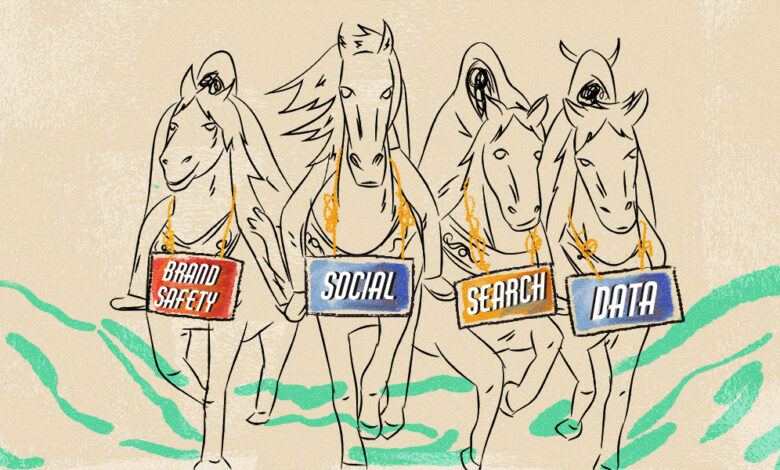Media Briefing: What to expect at the Digiday Publishing Summit, September 2024 edition

This article is part of Digiday’s coverage of its Digiday Publishing Summit. More from the series →
So far, 2024 is looking pretty good — especially compared to last year — but that doesn’t it hasn’t been without challenges. Referral traffic from search and social platforms is still lackluster; generative AI technology is still transforming the media industry (despite whether publishers want it); and Google’s decision to walk back its third-party cookie deprecation plans came as quite the shock after five years of preparation.
All that and much more will be discussed during the Digiday Publishing Summit next week, Sept. 23-25, in Key Biscayne, Fla. And in between catching rays and catching up, publishing execs from Axios, Bloomberg, Disney, Hearst, Time and many more will take the stage to unveil their strategies for facing the biggest threats and opportunities in the digital media industry right now.
Next week there will be more in-depth recaps of what was said during those on-stage discussions, as well as an overheard from the summit in our next Media Briefing. But for now, here’s a look at some of the topics that will be discussed at this fall’s DPS.
Digiday’s managing editor Sara Jerde and executive editor of audio and video Tim Peterson contributed to this briefing.
Cookie conundrum
It wouldn’t be DPS without a session on third-party cookies, which may be even more prevalent this year following Google’s decision to ultimately flip its deprecation plans on their head.
In a session with Hearst’s svp of ad products and data, Jen Dorre, we’ll discuss what comes next for publishers who have invested heavily in testing alternatives to third-party cookies, and the changes to measurement that publishers can expect to see as a result.
Knowing how make the most out of an online audience
Between ever-changing search algorithms and always-growing walls around social platforms, digital publishers are grappling with a severely fragmented online audience. To not let that jeopardize their bottom lines, publishers need to figure out how to capture audiences on- and off-site while also monetizing them as effectively as possible.
For Time, this means going against the grain from what digital publishers have been told, and dropping its digital subscription product in favor of driving more advertising revenue. It also means embracing emerging technology — like generative AI. In this session, we’ll dig into Time’s digital evolution with chief operating officer Mark Howard and why the company is embracing a business-to-business mindset in its ad business rather than a consumer one.
For Bloomberg, the B2B publisher is exploring more points of audience engagement — like distributing its video archive on lucrative platforms like LinkedIn, or building out new event franchises around the world — all with the goal of turning those viewers and attendees into subscribers. Chief digital officer Julia Beizer will discuss how her team is creating more streams into the subscriber funnel while also adding value to keep audiences coming back.
Establishing niche audiences for growth
As the internet becomes more and more niche, some publishers are finding growth in catering to these specific, albeit smaller, groups of interested readers.
Punchbowl News, for instance, launched in 2021 with the goal of catering to the “influential people in Washington.” Since then, it has grown from five employees to 35, according to Anna Palmer, CEO and founder of Punchbowl News. During her on-stage session, Palmer will talk about why she’s laser focused on catering to Punchbowl’s community members and how the news organization has used that ethos to figure out how to best engage them — from corn hole tournaments to texting the news (but not marketing messages).
Axios’s approach is similar in nature, by posing the brand and its journalists as authorities in the various niches it covers. But Jacquelyn Cameron’s role as CRO of the media company is more so focused on selling advertisers its subject matter expertise and creating marketable opportunities, like events and newsletters, through the niche audiences Axios convenes.
Maintaining a DEI policy
As the election year heats up, the ad industry at-large has quietly lessened its pressure to maintain a DEI strategy. Some brands have come out and said it’s not an issue they’re prioritizing. In publisher land, some media organizations have failed to grow their non-white employee headcount.
Vox Media’s Head of DEI Chris Clermont will talk about how the topic has been prioritized across the company with various leads representing each department. Additionally, he’ll discuss how executives within media companies can prioritize maintaining a DEI strategy without sacrificing the bottom line.
Moving from gut instinct to AI
Prior to this year, Business Insider’s paywall subscriber strategy rested on the shoulders of the editorial team, who relied on their instinct to decide which specific stories were most likely to convert passive audiences into paid readers. But chief subscription officer Katie Friedman, who joined the company in early 2023, challenged that notion with the theory that all of the publication’s articles had the opportunity to convert readers, if they were paywalled for the right audiences.
So Friedman spent the better part of this year putting that theory to the test, swapping the publisher’s old, intuition-based system with a new AI-powered paywall that was designed to put up a paywall on any content it thought an individual user would likely pay for.
In her session on Monday, Friedman will discuss how her team created and tweaked their AI-powered paywall in the launch phase to ultimately yield a 75% higher conversion rate, compared to the old paywall strategy.
AI in ad sales
And speaking of generative AI, publishers have begun to incorporate the buzzy new technology into their advertising businesses, among them being Dow Jones and The New York Times.
Touting a product called BrandMatch, The Times’s use of AI creates unique targeting segments for advertisers that it hopes will increase ad revenue as a result. Bailey Evans, NYT’s executive director of strategic operations, will discuss early findings from this tool and how she’s thinking of solutions from other challenge areas in the publishing industry, from search to cookie depreciation.
Dow Jones, on the other hand, is using generative AI to make its advertising operations more efficient — and therefore, more lucrative. During his session, Kedar Prabhu, Dow Jones’s vp of ad product and technology, will discuss how AI is helping his team automate the building of more than 4,500 media plans that the company creates every year, as well as how he assesses whether or not to build or buy AI technology.
Building a new brand from a legacy media outlet
The media industry is no stranger to thinking and innovating for the subscriber journey: From bundling non-news services with habit-forming products, such as The New York Times’ Games, to special subscription offers for students that will hopefully make them loyal, full-price paying readers once they have the paycheck to do so.
Fortune’s latest take on that tactic is creating a new vertical, called Next to Lead, that targets up and coming movers and shakers in the C-Suite. The brand is building out its first list honoring “the next generation of CEOs,” said Ruth Umoh, Next to Lead editor. All the while, it’s strategizing around using the legacy media outlet’s data and network of advertisers to grow.
The future of video is FAST and automatic
Disney and Telemundo will take the stage at DPS to discuss where they’re investing when it comes to monetizing video assets.
For Disney, a priority has been priming the programmatic pipelines and improving the accuracy of CTV measurement to drive a more automated stream of ad revenue. During a live recording of the Digiday Podcast, Jamie Power, Disney’s svp of addressable sales, will talk about how programmatic figures into Disney’s upfront deals and how the company is training its sales team to be more knowledgeable about programmatic.
During Telemundo’s session, the focus will be on the company’s FAST strategy, which can be summarized in two case studies — the launch of a news-centric FAST channel earlier this year and the planned launch of a sports-centric FAST channel next year, according to Joaquin Duro, the company’s svp of AVOD, streaming and digital.
What we’ve heard
“It’s hard for me to say one way or another, but even if [Google does] spin it off, it’s still not like there’s going to be a competitor tomorrow, right? There’s been such a long time of no entrants to the market within the ad server space; it’s not like a new competitor is going to pop up tomorrow that’s going to help publishers.”
— A media exec on what happens if Google’s ad server is severed from the company as a result of the antitrust trial.
Numbers to know
$32 million: The amount of money that Air Mail, Graydon Carter’s 5-year-old media start-up, has raised to date. After a reported acquisition by Standard Investments worth $50 million fell through earlier this year, the company has hired boutique investment bank Raine Group to continue exploring sale opportunities.
$33 million (or £25 million): The amount of money that media start-up Tortoise Media is willing to invest in The Observer over the next five years, if it were to buy the British Sunday newspaper off of Guardian Media.
€13.5 billion (or about $15 billion): The value of media conglomerate Axel Springer, which is nearing an agreement with private equity firm KKR that would separate the company’s classifieds business from its media properties.
What we’ve covered
Publishers’ ad revenue rebounded in the first half, but H2 is looking even brighter:
- The crisp autumn breeze is not the only breath of fresh air washing over the media industry this season.
- Deal size of direct-sold advertising campaigns (ranging from custom content to programmatic guaranteed) and RFP volume were both up in Q1 and Q2 this year.
See how publishers’ advertising businesses are pacing this year here.
X is on the hunt for more ad dollars at its latest client council meeting:
- Looks like big advertisers aren’t slamming the door on X just yet, even if their relationship with its owner, Elon Musk, is more drama than deal-making.
- How else do you explain 80 marketers showing up at X’s New York HQ on Sept. 17 for another client council session?
Read more about X’s efforts to woo advertisers back to the platform here.
Google might be close to a breakup, but sources warn authorities to ‘be careful what you wish for’:
- The Department of Justice is spearheading efforts to break up Google, accusing it of a decades-long attempt to monopolize the $600 billion online advertising market.
- Although, would a divestiture be that simple or even practical?
Hear from industry experts about the impact of the Google antitrust result here.
Broadcasters and advertisers expected a lot from the Olympics — was it worth it?:
- NBCU secured a 60% increase in sales resulting in $1.2 billion in ad revenue, its highest-ever tally for the Olympic Games.
- Media companies are still crunching the numbers to figure out which channels were most useful and how many viewers engaged with the thousands of hours of broadcast sport.
See more stats about the 2024 Olympic Games’ performance here.
The definitive Digiday guide to what’s in and out at DMEXCO 2024:
- Digital advertising is in the midst of a major shake-up, juggling heightened privacy concerns and the looming question mark over third-party cookies.
- Dive into our rundown of what’s trending and what’s tanking at this year’s conference to stay ahead of the curve.
Learn the latest about what’s going on at DMEXCO here.
What we’re reading
X’s new marketing chief has a lot of work ahead of her:
Angela Zepeda was tapped as the new head of marketing at X (formerly Twitter), which may be the biggest challenge of her career, The Wall Street Journal reported. Zepeda will be tasked with repairing relationships with key advertisers in her new role, after the platform’s owner, Elon Musk, publicly severed many of those ties over the past couple of years.
BuzzFeed wants Netflix to bring its ‘Hot Ones’ show to streaming:
Axios reported that BuzzFeed is working with Netflix to create a live version of the digital media company’s “Hot Ones” show, in an effort to make a significant dent in paying off its more than $100 million of debt. The companies are aiming to solidify the deal this month.
A Nevada court will decide the fate of Rupert Murdoch’s media empire:
A probate commissioner in Nevada, Edmund J. Gorman Jr., will hear evidence regarding the future of Rupert Murdoch’s media empire, which includes Fox news and News Corp, per The New York Times. The fight over the next couple of weeks will ultimately determine who of Murdoch’s children will gain control of the businesses after he passes.
Instagram makes sweeping privacy changes to teen accounts:
All accounts owned by kids under 16-years-old were made private after Instagram upped its safety settings this week. NPR reported that under age users will now require parental approval to turn off these privacy settings, which also include filters on offensive words and restricted contact with other users.
TikTok’s appeal to a panel of judges was met with a skepticism:
On Monday, TikTok made an argument in front of three judges in the DC Circuit Court of Appeals about why the social platform should not be banned in the U.S. The Verge reported that the panel expressed a lot of skepticism, however, after hearing TikTok’s case.



